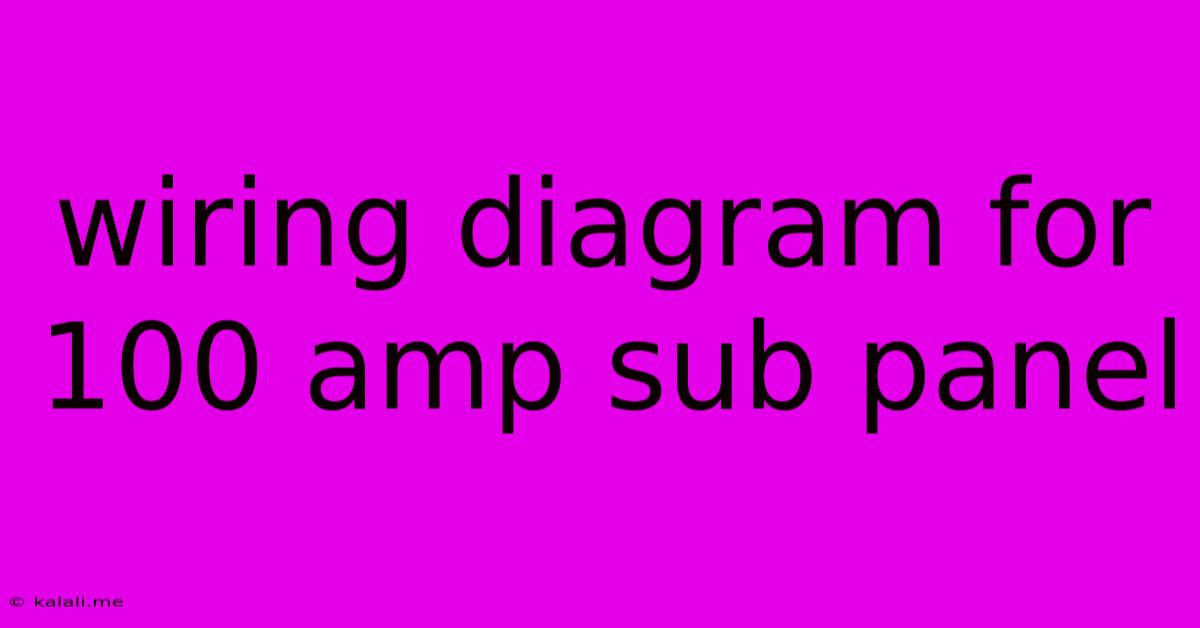Wiring Diagram For 100 Amp Sub Panel
Kalali
May 25, 2025 · 3 min read

Table of Contents
Wiring Diagram for a 100 Amp Sub Panel: A Comprehensive Guide
This article provides a comprehensive guide to understanding and creating a wiring diagram for a 100-amp sub panel. We'll cover the essential components, safety precautions, and step-by-step instructions to ensure a safe and correctly wired installation. Improper wiring can lead to electrical hazards, so always prioritize safety and consult a qualified electrician if you're unsure about any aspect of this process.
Understanding the basics of sub panel wiring is crucial for homeowners and DIY enthusiasts undertaking electrical projects. This guide will help you visualize the process, choose the right materials, and plan your installation effectively. We'll explore the different wire sizes, breaker types, and grounding techniques required for a 100-amp sub panel.
Essential Components for Your 100 Amp Sub Panel Wiring Diagram
Before diving into the diagram, let's identify the key components you'll need:
- 100 Amp Main Breaker Panel: This is the primary distribution point for your electrical system.
- 100 Amp Sub Panel: This secondary panel distributes power to specific areas of your home or building.
- Appropriate Gauge Wire: The wire size depends on the distance between the main panel and the sub panel, and the amperage requirements. For a 100-amp sub panel, you'll likely need a larger gauge wire (e.g., 2/0 AWG or larger) to handle the current. Always check local electrical codes for specific requirements.
- Ground Wire: A dedicated ground wire is essential for safety. It provides a path for fault currents to flow back to the ground, preventing electrical shocks.
- Circuit Breakers: These protect individual circuits from overloads and short circuits. The number and amperage ratings of the breakers will depend on the load requirements of your sub panel.
- Electrical Conduit: This protects your wiring from damage and provides a safe and organized installation. Metal conduit is preferred for its added safety features.
- Connectors and Terminals: These are used to connect wires securely to the breaker panel and other components.
Step-by-Step Guide to Creating Your Wiring Diagram
Creating a clear and accurate wiring diagram is vital before starting any electrical work. Here's a suggested approach:
-
Plan Your Circuits: Identify the circuits you need in your sub panel (e.g., lighting, outlets, appliances). Determine the amperage rating required for each circuit.
-
Choose Your Breakers: Select appropriate circuit breakers for each circuit based on the amperage requirements. Remember to leave room for future expansion.
-
Determine Wire Gauge: Calculate the required wire gauge based on the distance between the main panel and the sub panel, the amperage of the circuits, and local electrical codes. Consult a wire gauge chart or use an online calculator for accurate calculations.
-
Draw the Diagram: Create a schematic diagram showing the connections between the main panel, the sub panel, the circuit breakers, and the ground wire. Use standard electrical symbols for clarity. Label all components and wires clearly. Include the wire gauge and amperage ratings for each circuit.
-
Grounding: Ensure proper grounding connections are included in your diagram. The grounding wire should be connected to the ground bus bar in both the main panel and the sub panel.
-
Review and Verify: Before beginning installation, carefully review your diagram to ensure accuracy and consistency with local electrical codes.
Safety Precautions: Always Prioritize Safety
- Turn Off the Power: Always disconnect the power to both the main panel and the sub panel before beginning any wiring work.
- Use Appropriate Tools: Employ the correct tools for the job, including wire strippers, crimpers, and voltage testers.
- Follow Local Codes: Adhere to all local electrical codes and regulations.
- Consult a Professional: If you're unsure about any aspect of the process, consult a qualified electrician.
This comprehensive guide provides a solid foundation for creating a wiring diagram for your 100-amp sub panel. Remember, electrical work can be dangerous. Always prioritize safety and, if in doubt, consult a qualified professional. This information is for guidance only and does not substitute professional electrical advice.
Latest Posts
Latest Posts
-
How To Remove Scratches From Windscreen
May 26, 2025
-
R Showing All Entries As Singularity In Regression
May 26, 2025
-
Pex A To Pex B Adapter
May 26, 2025
-
Thou Shalt Not Suffer A Witch To Live
May 26, 2025
-
How To Keep Fruit Flies Away
May 26, 2025
Related Post
Thank you for visiting our website which covers about Wiring Diagram For 100 Amp Sub Panel . We hope the information provided has been useful to you. Feel free to contact us if you have any questions or need further assistance. See you next time and don't miss to bookmark.